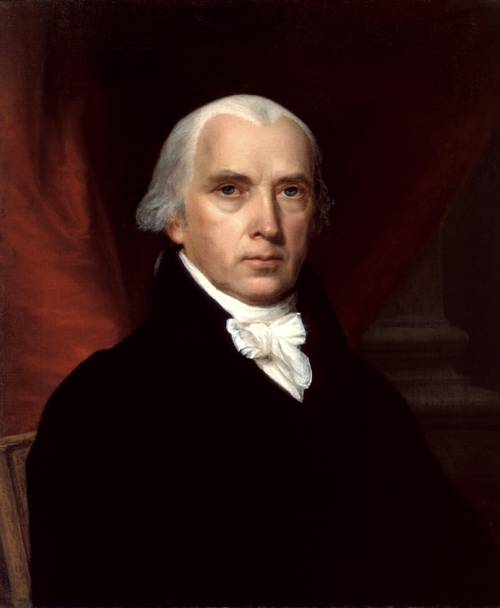
FAQ About James Madison

Who was James Madison?
James Madison was the fourth President of the United States, serving from 1809 to 1817. He is primarily known for being a key architect of the U.S. Constitution and the Bill of Rights, earning him the title 'Father of the Constitution'.

What were James Madison's major contributions to the U.S. Constitution?
James Madison played a crucial role in drafting and promoting the U.S. Constitution and the Bill of Rights. He was a leading advocate for a strong federal government and contributed significantly to the Federalist Papers, which helped persuade states to ratify the Constitution.

When did James Madison serve as President of the United States?
James Madison served as the President of the United States from March 4, 1809, to March 4, 1817.

Why is James Madison known as the 'Father of the Constitution'?
James Madison is known as the 'Father of the Constitution' because of his pivotal role in the document's drafting and his contributions to the Federalist Papers, which were instrumental in getting the Constitution ratified. His Virginia Plan was also influential in shaping the new government structure.

What are some interesting facts about James Madison?
James Madison was the shortest U.S. president at 5 feet 4 inches (163 cm) and weighed about 100 pounds (45 kg). He also had a significant influence on the Louisiana Purchase negotiations and was married to Dolley Madison, who became famous for her social graces and hospitality.

What was James Madison's role in the Bill of Rights?
James Madison was instrumental in drafting the first ten amendments to the United States Constitution, known as the Bill of Rights. He introduced these amendments in the First Congress and advocated for their adoption to ensure personal freedoms and limit government power.

How did James Madison contribute to the Federalist Papers?
James Madison, along with Alexander Hamilton and John Jay, wrote the Federalist Papers, a series of 85 essays promoting the ratification of the United States Constitution. Madison authored 29 of these essays, providing key arguments for a strong federal government.

Where was James Madison from?
James Madison was born in Port Conway, Virginia, on March 16, 1751. He was raised on the family plantation in Orange County, Virginia, known as Montpelier.

What were some challenges James Madison faced during his presidency?
During his presidency, James Madison faced the War of 1812 against Great Britain, which tested the young nation's resolve and military capabilities. Domestically, he dealt with Native American conflicts and economic difficulties due to the war and the subsequent trade restrictions.

What legacy did James Madison leave behind?
James Madison left a lasting legacy as a Founding Father of the United States and as the principal author of the Constitution. His efforts in establishing foundational governance structures continue to influence American political thought and constitutional law today.

How did James Madison influence American political thought?
James Madison's political thought emphasized a balance between liberty and government power, as reflected in the U.S. Constitution. His ideas on checks and balances and the separation of powers are fundamental to American government and continue to influence modern political theory.

What education did James Madison have?
James Madison graduated from the College of New Jersey, now known as Princeton University, in 1771. He studied subjects such as Latin, Greek, science, and philosophy, and was known for his strong academic performance.

Was James Madison involved in any significant international events?
Yes, during his presidency, James Madison navigated significant international challenges, most notably the War of 1812 against Great Britain. This conflict was largely about British restrictions on American trade and the impressment of American sailors.

What was Dolley Madison's role during James Madison's presidency?
Dolley Madison played an essential role as First Lady, renowned for her social and diplomatic skills. She is credited with defining the role of the First Lady and is famous for saving a portrait of George Washington during the burning of Washington in 1814.

How did James Madison's Virginia Plan influence the Constitution?
The Virginia Plan, proposed by James Madison, was a blueprint for a new federal government, advocating for a strong national government with three branches. It influenced the structure and content of the final Constitution, particularly in its vision for a bicameral legislature.

Did James Madison have any influential political opponents?
During his political career, James Madison faced opposition from figures like Alexander Hamilton over the balance of federal and state powers. Disagreements with Hamilton led to the formation of America's first political parties, with Madison aligning with Thomas Jefferson to found the Democratic-Republican Party.

What was James Madison's involvement in the Louisiana Purchase?
Although the Louisiana Purchase took place under Thomas Jefferson's presidency, James Madison, as Secretary of State, helped negotiate the purchase. The acquisition doubled the size of the United States and significantly impacted its development.

How was James Madison's health during his life?
James Madison suffered from chronic health issues throughout his life, including debilitating bouts of what was then called "bilious fever" and later thought to be some form of epileptic or stress-related disorder. Despite his health challenges, he lived to the age of 85.

What were James Madison's views on slavery?
James Madison owned slaves throughout his life, yet he expressed ambivalence about slavery and its moral implications. He advocated for gradual abolition and proposed relocating freed slaves outside the United States, though he never freed his own slaves.

Did James Madison have any major legislative achievements during his presidency?
One of James Madison's notable legislative achievements was the rechartering of the Bank of the United States in 1816, despite earlier opposition. His presidency also saw the enactment of the Tariff of 1816, which aimed to protect American manufacturing post-War of 1812.
